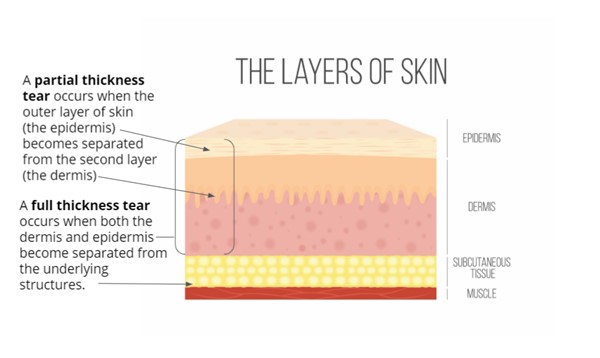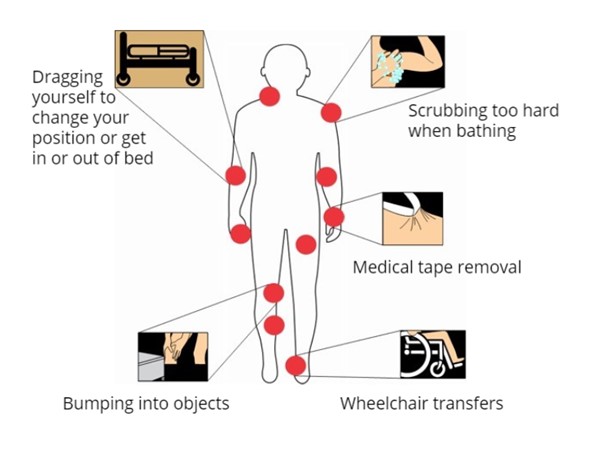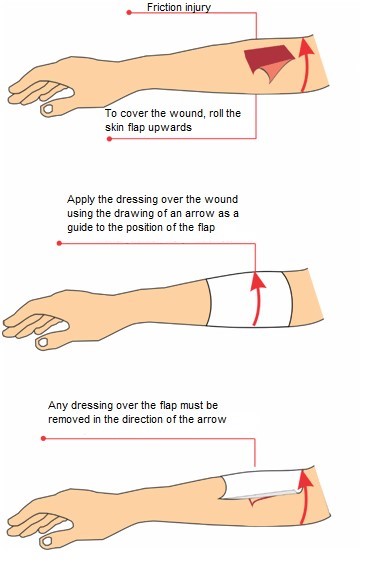Summary
A skin tear occurs when the outer layers of the skin separate or peel back due to trauma. Skin tears are caused by mechanical forces, including removal of adhesives.
Treatment
-
It is important to address the causes that lead to skin tears, and minimize risks of developing new skin tears.
- Local wound care includes cleansing, repositioning of the injured skin, and application of dressings. There are several different types of dressings that are used to protect and aid the healing of skin tears. They are used to prevent the wound from getting too dry and to prevent the dressing from sticking to the bedding.
When to contact your healthcare provider
Don’t wait or hesitate to contact if you are experiencing new problems or symptoms, your wound begins bleeding excessively, or if you have a fever or other signs of infection.
|
Patient Education Handout (download)
|
WHAT is a skin tear?
A skin tear occurs when the outer layers of the skin separate or peel back. Skin tears are most common in older adults, as they tend to have more fragile skin which occurs with age. Newborn infants are also at higher risk. Acute skin tears typically heal within 4 weeks, while more complex skin tears may require additional, long-term treatment.
The severity of skin tears can vary by depth (Figure 1):

Figure 1. S everity of skin tears can
vary by depth
Skin tears are most commonly located on the arms, hands, legs and feet. Common locations and causes are shown in the picture below (Figure 2).

Figure 2. Common locations and causes of skin tears
WHAT causes a skin tear?
Skin tears are caused by mechanical trauma.
Some examples of traumas that often cause skin tears are:
- Blunt force, such as bumping into an object
- As a result of a fall
- Removal of medical dressings and treatments
- Wheelchair transfers
- Equipment injury (e.g. side rails)
In younger people, the most common cause of skin tears is the removal of the strong medical tape that is used to secure bandages, gauze, and other dressings to the skin.
The following risk factors can make a person more likely to experience a skin tear:
- Age: Skin becomes more fragile and dry with age
- Reduced mobility: Difficulty in moving around or performing daily activities can lead to accidents, such as bumping against objects, falls or skin bruises.
- Chronic disease: Certain illnesses, such as diabetes, Alzheimers, heart disease or cancer can make it harder for you to see, hear or feel. This can lead to falls and injuries that cause skin tears.
- Certain medications: Corticosteroids, used to treat conditions such as asthma, allergies, psoriasis, and more, can cause significant skin changes. Taking multiple medications at a time can also lead to skin changes and increased risk for skin injuries and tears.
HOW do I care for my skin tear?
If you experience a skin tear at home:
- Apply pressure if the wound is bleeding
- Clean the site with soap and water
- If there is a flap of skin, gently lay it back in place
- Cover the wound with a gauze wrap
HOW does a clinician treat a skin tear?
Once the wound has been examined by your clinician, there are several common steps in the treatment protocol (Figure 3):
- Clean the wound: A solution is used to clear out any blood or harmful debris
- Approximate the skin flap: If the damaged flap of skin is viable the physician will put it back into place. If there is non-viable tissue present, the physician will debride, or remove, the tissue to avoid infection.
- Bandage the wound: There are several different types of dressing that are used to protect and aid the healing of skin tears. They are used to prevent the wound from getting too dry and to prevent the dressing from sticking to the bedding.

Figure 3. Skin tear treatment
WHAT can happen if my skin tear is left untreated?
If a skin tear is left untreated, complications due to bleeding and infection can arise. Skin tears that are not properly dressed may not heal, and can re-tear or become a chronic wound.
WHEN should I contact my healthcare provider?
- Don’t wait or hesitate to contact if: you are experiencing new problems or symptoms, your wound begins bleeding excessively, or you see signs of infection.
- Signs of infection: fever, nausea, wound redness, warmth, swelling, pain, or a change in wound drainage, odor, or color.
HOW can I prevent a skin tear?
- Be familiar with your surroundings and aware of your environment, especially if you have difficulty moving or fall frequently
- Use walkers or canes for support, if needed
- Be aware that some medications can affect your skin. Be sure to discuss these potential side effects with your clinician or pharmacist
- Avoid the use of tapes on skin
- Keep skin moisturized with lotions or creams
- Eat well and drink a lot of water